In a recent podcast interview, oft-controversial media mogul Rupert Murdoch sounded a positive note on print newspapers. Long considered the dinosaurs of the media ecosystem, they’re poised to “reach new heights” in the 21st century, according to Murdoch.
If anyone would be inclined to take this seemingly contrarian view, it would be Murdoch, the owner of several successful newspapers, including The Wall Street Journal. As he pointed out in the discussion, the Journal was the only one of the 10 largest major dailies in the United States to post growth in paid subscriptions last year.
So how are print newspapers going to survive and thrive in a larger, more diverse media market? Simple — they’re going to de-emphasize their print offerings. Murdoch acknowledged that print circulation likely will go down in coming years. However, he added that “if papers provide readers with news they can trust, we’ll see gains in circulation — on our web pages, through our RSS feeds, in emails delivering customized news and advertising, to mobile phones. In short, we are moving from newspapers to news brands.”
In other words, newspapers will grow if they embrace new forms of effective media and don’t get tied to the old way of doing things. Furthermore, they should integrate all of their offerings into a coherent, trusted brand.
Hearing Murdoch talk about where newspapers are going got me thinking about how learning executives reach their audiences. Most of them already have accepted and even welcomed the idea of incorporating new modalities — such as simulations, games and social networks — with more traditional approaches — such as ILT and printed manuals. But have they worked to combine these under a single brand that employees recognize and rely on? I know a few companies have done this: GE and Goldman Sachs come to mind. But I’m not sure it’s common practice in the learning space yet.
What are your thoughts about branding learning offerings? Do you practice this in your organization, or do have plans to? Let us know about your efforts in this area in the “Branding the learning function” discussion on the CLO-Network.














